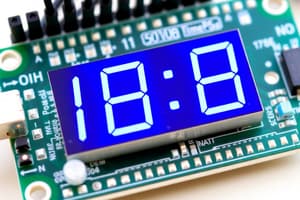Podcast
Questions and Answers
What is an interrupt in the context of a microcontroller?
What is an interrupt in the context of a microcontroller?
- A method of servicing multiple devices simultaneously
- A program that continuously monitors the status of a device
- A device that serves the microcontroller
- An external or internal event that informs the microcontroller of a device's need for service (correct)
What is the purpose of the interrupt service routine (ISR)?
What is the purpose of the interrupt service routine (ISR)?
- To notify the microcontroller of a device's need for service
- To interrupt the microcontroller's current task
- To monitor the status of a device
- To perform the service required by the device (correct)
What happens when a microcontroller receives an interrupt signal?
What happens when a microcontroller receives an interrupt signal?
- It continues with its current task
- It interrupts its current task and serves the device (correct)
- It monitors the status of the device
- It services all devices simultaneously
What is the main difference between interrupt and polling?
What is the main difference between interrupt and polling?
What is the benefit of using interrupts in a microcontroller?
What is the benefit of using interrupts in a microcontroller?
What is the role of the microcontroller in polling?
What is the role of the microcontroller in polling?
What is the first step in executing an interrupt?
What is the first step in executing an interrupt?
What is the purpose of the interrupt vector table?
What is the purpose of the interrupt vector table?
What is the last instruction of the interrupt service subroutine?
What is the last instruction of the interrupt service subroutine?
What is the function of the IE register?
What is the function of the IE register?
What is the purpose of the IP register?
What is the purpose of the IP register?
How many sources of interrupts are there in the original 8051?
How many sources of interrupts are there in the original 8051?
Flashcards are hidden until you start studying
Study Notes
Interrupts
- An interrupt is an external or internal event that informs the microcontroller that a device needs its service.
Interrupt vs Polling
- Interrupts:
- The device notifies the microcontroller by sending an interrupt signal when it needs service.
- The microcontroller interrupts its current task and serves the device.
- The associated program is called the Interrupt Service Routine (ISR) or interrupt handler.
- Polling:
- The microcontroller continuously monitors the status of a given device.
- When conditions are met, it performs the service and moves on to monitor the next device.
Steps in Executing an Interrupt
- Finishes the current instruction and saves the address of the next instruction (PC) on the stack.
- Saves the current status of all interrupts internally (not on the stack).
- Jumps to a fixed location in memory, the interrupt vector table, which holds the address of the ISR.
- Retrieves the address of the ISR from the interrupt vector table and jumps to it.
- Executes the interrupt service subroutine until the RETI (return from interrupt) instruction.
- Upon executing RETI, the microcontroller returns to the interrupted location.
8051 Interrupts
- The original 8051 has 6 sources of interrupts: Reset (RST), Timer 0 overflow (TF0), Timer 1 overflow (TF1), External Interrupt 0 (INT0), External Interrupt 1 (INT1), and Serial Port events (RI+TI).
- 8051 Interrupt Vectors: 8
- 8051 Interrupt-related Registers: 9
Interrupt-related Registers
- TCON: Edge and Type bits for External Interrupts 0/1
- SCON: RI and TI interrupt flags for RS232 (Serial Communication)
- IE: Interrupt Enable (responsible for enabling/disabling interrupts)
- IP: Interrupt Priority (assigns high or low priority to interrupts)
Enabling and Disabling Interrupts
- The IE (Interrupt Enable) register enables (unmasks) or disables (masks) interrupts.
- IE Register:
- EA: Global enable/disable
- ES: Enable Serial port interrupt
- ET1: Enable Timer 1 control bit
- EX1: Enable External 1 interrupt
- ET0: Enable Timer 0 control bit
- EX0: Enable External 0 interrupt
Studying That Suits You
Use AI to generate personalized quizzes and flashcards to suit your learning preferences.




